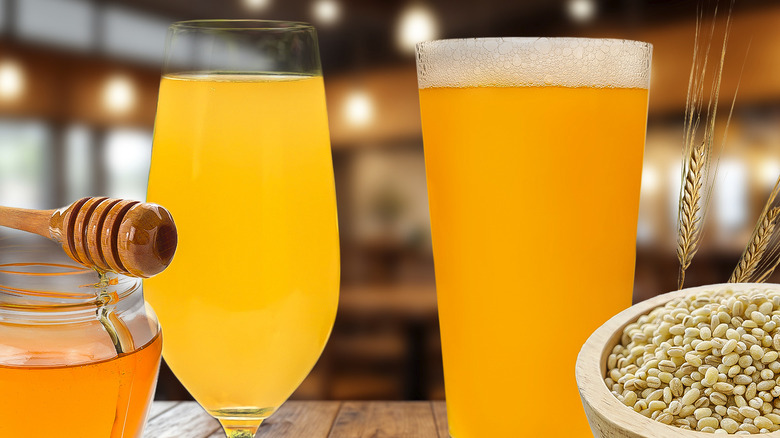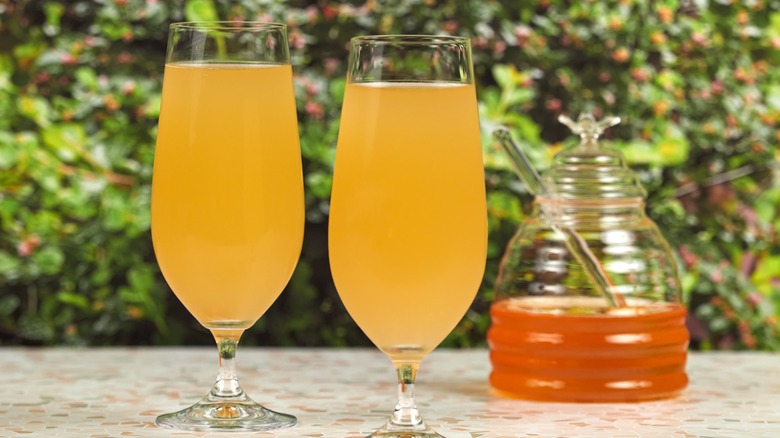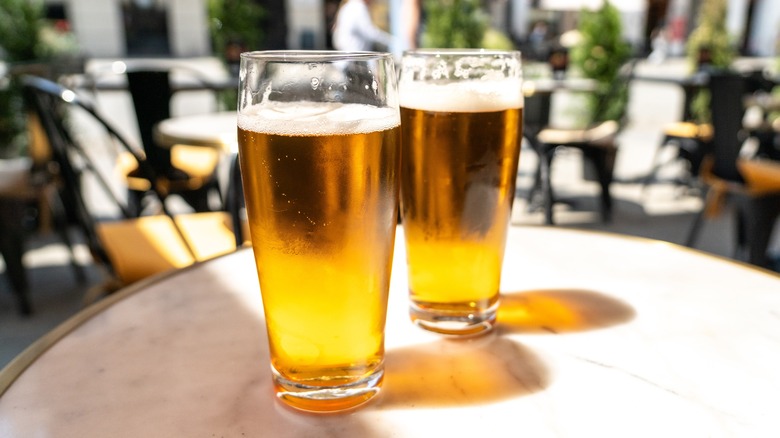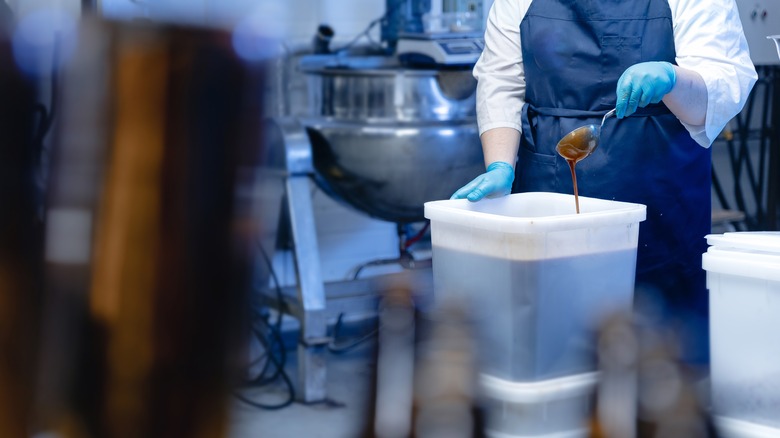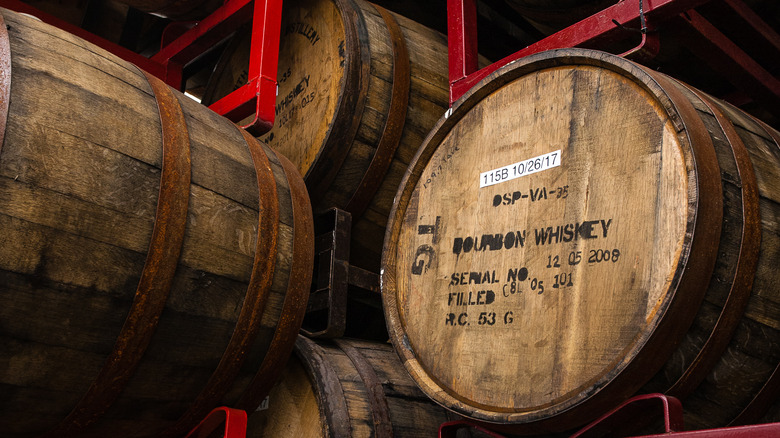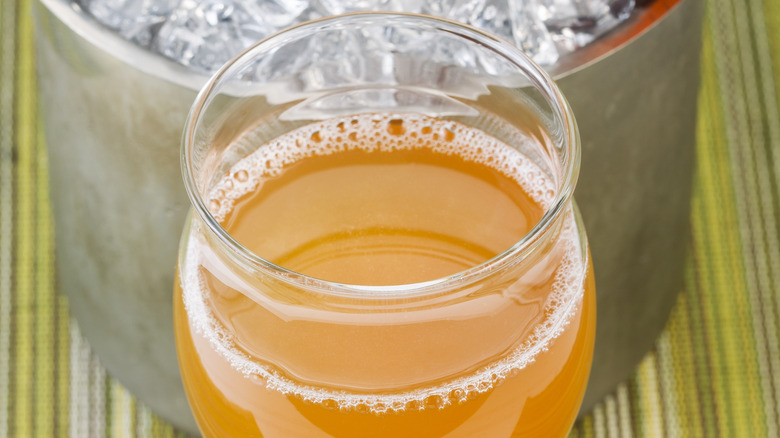Mead Vs Beer: What's The Difference?
Upon first glance, goblets of mead may look similar to glasses of cider or ale. While mead, a type of honey wine, shares many similarities with beer, there are also plenty of differences that separate these two fermented drinks. Mead goes back, way back to a time before wine was invented, and was used in ancient ceremonies. Chinese pottery with traces of the stuff can be traced to 7,000 BCE and Vikings and Greek philosophers have been known to imbibe over the centuries. Described as nectar of the gods, mead is a fierce contender to lay claim as the first alcoholic drink. And while mead might have once fallen out of popularity, it has made a comeback and is still enjoyed today.
Before you start writing off goblets of mead as the same as beer, know that these two alcoholic beverages are not the same. The ingredients used, the processes by which these drinks are made, and the resulting flavors differ between the drinks. You may want to chug a pint of beer, but mead, with an ABV that can range from 8% to 20% is a choice that is much better to sip. Serve yourself a pint of your favorite brew, and let's dive into these two concoctions.
What is mead?
Mead is in a league of its own, as it doesn't fall under the categorical umbrella of either beer or wine. Mead is essentially fermented honey, water, and yeast. Some mead makers will decide to add spices and other ingredients like fruit to build more complex tasting notes in the drink. Depending on the recipe and the kind of honey used to make mead, the tasting notes found in your glass of mead can span from a drink that resembles a light fruity wine to something more tangy and zippy, closer to what could be mistaken for a cider.
Mead can be sparkling, still, dry, or sweet, so there are plenty of different types to taste and compare, and mead doesn't need to be enjoyed served in a cold glass, either. The drink can be used in cocktail recipes, like a comforting batch of hot mulled mead spiced with cloves, cardamom, cinnamon, and nutmeg, then spiked with a splash of brandy.
What is beer?
A suspected baking accident may have led to the discovery of beer. Beer is made from fermented grains — usually corn or barley — hops, and yeast. Broadly speaking, any drink that is made by fermenting some kind of grain can be classified as a beer. Beer is composted mostly of water, however, and the type of water taken from a place can largely influence the different kinds of beers available and the taste of the final brew.
Carbonated and fermented, beer can range in alcohol content anywhere from 3 to 13% ABV, with most brews landing in the 4 – 7% ABV range. The variety of brews is vast, and crisp pints can range from classic lagers to uniquely crafted beers, with modern breweries adding unique flavors to their concoctions and using innovative processes to package their wares. Hobbyists can make beer at home, adding bourbon-soaked oak chips to soak and ferment or using malt extract to build out flavor in smaller batches of creatively made libations.
Ingredients used in brews
The fermentation processes involved in making both beer and mead require sugars, as the yeast feeds off the source to result in the alcohol content we can appreciate in a poured pint. But while barely provides this sugar source in the process of making beer, honey offers the sugars that the yeast feeds off in mead. You'll find some overlap in certain kinds of meads and beers once they are served, but it is safe to say that grains don't usually come into play when mead is made.
Additionally, just as the grains chosen to brew beer will impact the taste of the drink that ends up in your glass, the type of honey used to make mead will similarly affect the flavor of the finished product. Different honey varieties present unique tasting notes that will flavor the final brew. Mead made with a milder honey like clover or orange blossom may pack less of a spice than one made with buckwheat honey, for example.
The making of the drink
Though both beer and mead are fermented, to get to the step of fermentation, beer requires a bit more prep work as boiling must take place before fermentation begins. This kind of extreme heat isn't needed to make mead. Once this fermentation is kicked into gear, beer is on a clock before it is placed into bottles, while mead is stored away and left, sometimes for years, to age. Once bottled and stored, mead will ferment on its own whereas beer requires a more involved hand on the part of the brewer.
The process to make mead is more straightforward and simple, as beer-brewing requires turning grains into mash and separating wort from grain (lautering) before hops and yeast are added. Only then can fermentation take place. While beer brewers mix grains and spices to infuse flavors into water, mead relies on honey mixed with ingredients to add subtle, nuanced flavors to the final bottled beverage.
To age or not to age
Mead can become more rich and complex over time, while this same length of aging doesn't necessarily impact the profile of beer. When shopping for mead, the aging time can inform the way it will taste. Aged mead can be less harsh, as over time, oxidation results in mature flavors and an evolution in the container used to store the drink, like a barrel, a bottle, or a carboy. Additionally, high-alcohol meads need to be aged longer so that any sharper, harsher flavors mellow out. The range of aging mead can vary from six months to many years, and younger mead can offer zippier, brighter flavors that pack less of an alcoholic wallop.
While some brewers age beer to soften overpowering flavors, not all beers need to be placed into a cellar to mature. Sour, smoked, and higher alcoholic beers with more than 8% ABV are often aged, but hoppier beers like IPAs are best left outside of the cellar and consumed fresh, as hops are at risk of becoming muted and faded over time.
Understanding categories
Beer mainly falls into one of three categories, either a general ale or lager (commonly known brews like pilsners, porters, and stouts fall into these buckets) or an alternate hybrid category that is determined by the yeast type used in the beer-making process and the kind of fermentation that occurs to make the brew. Mead, on the other hand, is labeled first by the ingredients used to make the concoction and next by the alcohol present. Within this overarching broad category of mead, over a dozen different classifications exist.
While there is traditional dry mead that isn't flavored with other ingredients, there is also mead that can be made with fruits and spices that offers a lower alcohol content than other recipes. Mead called cyser is made with fermented honey and cider, pyment is made with grape wine, metheglin is spiced with herbs and spices, fruity melomel is packed with different kinds of fruits, and brackett is a mead made with grain, something closer to a stout.
Differences in flavor
Though it is hard to make sweeping generalizations of the tasting profiles of beer and mead, as a whole, beer will deliver a hoppier tasting experience. Mead will be a bit sweeter on the palate, but the range of different kinds of mead made can offer quite different flavors. The way in which honey is used during the mead-making process will impact the final taste. Honey can be re-introduced to mead after fermentation has taken place, or more honey can be used during the fermentation process, for example. From crisp, earthy, and tart to rich and spicy, mead provides a tasting landscape to explore, just like the expansive range of beers available to sip.
With so many different kinds of meads and beers to try, it is worth comparing notes of the kinds that you like — and to sample a range before you draw any conclusions whether you enjoy a particular libation or not.
